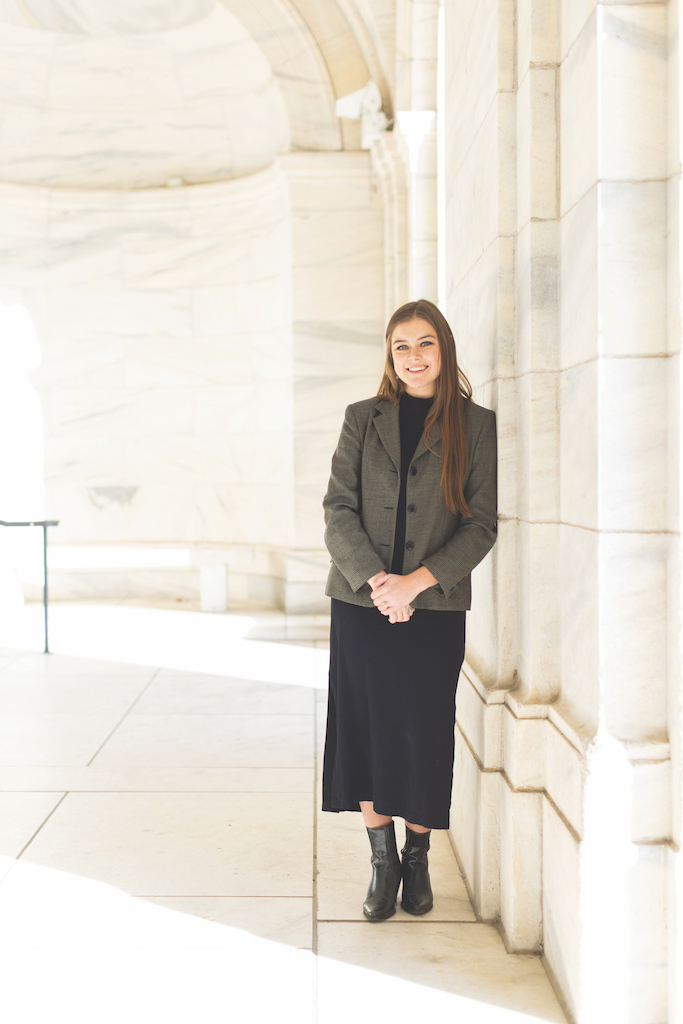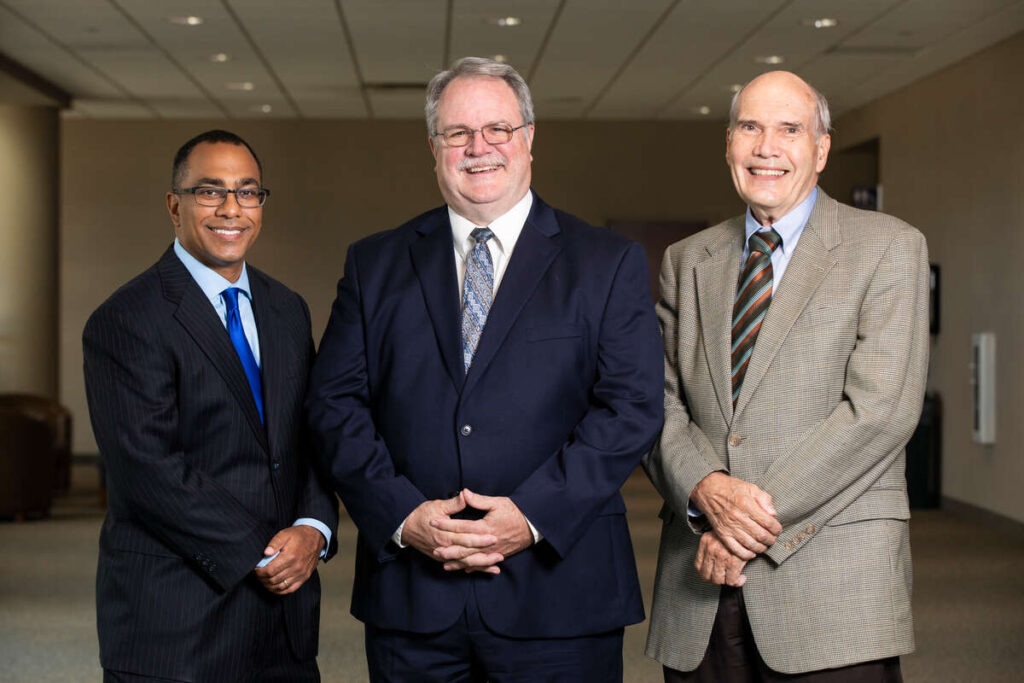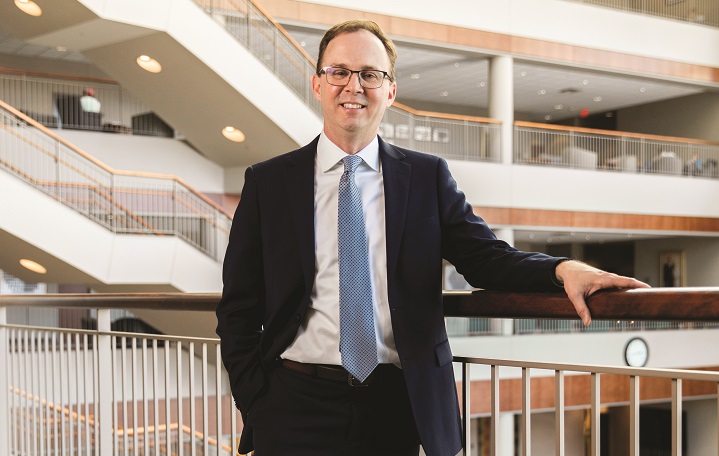Working with University of St. Thomas law librarians Valerie Aggerbeck, Debby Hackerson and Mary Wells, I recently released a study of the scholarly impact of the faculties at all law schools accredited by the American Bar Association. After conducting an empirical analysis of how scholarly writing by law professors is cited by other legal scholars, we ranked the top 70 law faculties in the country.
Together with other evidence of our faculty’s growing scholarly prominence, such as our frequent publication of articles in the nation’s leading journals, this study confirmed that the University of St. Thomas law faculty ranks comfortably among the top 40 law schools in the nation.
Within days of the announcement in mid-September, our Scholarly Impact Study was the subject of thousands of visits to our scholarly impact website. The full study report was downloaded hundreds of times, making it the second most downloaded law school paper in the nation for more than a week.1 After its release, nearly all of the major blogs devoted to law school news and legal scholarship included stories, debates and analysis of our study. For two weeks in September, the biggest story in law school news was the extended Scholarly Impact Score ranking produced at the University of St. Thomas.
Using the “Scholarly Impact Score” method refined by Professor Brian Leiter of the University of Chicago, the leading national blogger on law school news, our study found that a number of law schools, including Florida State, George Mason, Hofstra, Case Western, St. Thomas (Minnesota), Pittsburgh, Hawaii, Brooklyn, Nevada- Las Vegas, San Diego, Chicago-Kent and Missouri-Columbia achieve strong rankings well above those assigned by U.S. News.
In addition, we found that several law schools accredited within the past 12 years – St. Thomas, Nevada-Las Vegas, Chapman and Florida International – already have made a scholarly impact that dramatically outpaces their academic reputations.
Measuring the Scholarly Impact of Law Faculties
Scholarship is a public exercise in research, critical thinking, the search for truth and publication of the results. As legal scholars, we write for an audience. It is right and appropriate, then, to ask whether anyone is listening. In terms of scholarly impact, the crucial question is not whether other legal scholars notice our published work in passing, but whether they actually use our contributions in their own scholarly work.
In recent years, University of Chicago Professor Brian Leiter’s “Scholarly Impact Scores” have attracted increasing attention as a way to objectively measure how a law faculty collectively is succeeding in provoking exploration of ideas within the community of legal scholars. As refined by Leiter, the Scholarly Impact Scores measure the influence of the tenured law faculty of each law school by citations in the legal literature over the preceding five years.2
As with any measure of faculty quality or scholarly prominence, Scholarly Impact Scores are valuable only for what they depict and should not be mistaken as describing the whole of the academic cathedral.
We all recognize that some scholarly works of great value are targeted to a different or smaller audience than law professors generally. Thus, for example, effective pedagogical works and writings aimed at students are less likely to draw citations from other scholars, but instead may be recognized by other measures such as the number of downloads on the Social Science Research Network. Scholarly works directed to practicing lawyers and judges may draw attention as well by scholars, but these Scholarly Impact Scores assess the influence of such works only indirectly.
For these and other reasons, Leiter acknowledges that “one would expect scholarly impact to be an imperfect measure of academic reputation and/or quality.” But, Leiter adds, he is “confident that one will learn more about faculty quality at leading American law schools from the scholarly impact study … than from U.S. News.”
Moreover, scholarship is but one of three traditional roles for the law professor, who also is expected to teach students seeking to enter the legal profession and to provide public service to the profession or community. Still, we share Leiter’s view that “an assessment of academic institutions ought to weigh heavily the intellectual and scholarly caliber of the faculty, not to the exclusion of other factors, but as a way of putting education at the center of any evaluation of institutions in the business of educating.”3
The Nature and Methodology of This Scholarly Impact Study
This study explores the scholarly impact of the faculties of all law schools accredited by the American Bar Association and ranks the top 70 law faculties by their scholarly impact. Leiter previously has examined the scholarly impact of 34 law faculties, ranking the top 25. This study extends that examination to the remaining 167 law faculties of ABAaccredited law schools.
In methodology, we began by identifying the tenured law professors at each law school. In measuring citations to those faculty members confirmed to be tenured, we followed Leiter’s lead and accepted the titles as self-reported by law schools for the roster listings in the 2009-2010 Association of American Law Schools Directory of Law Teachers (AALS Directory).
If a tenured faculty member was specifically identified by title in the AALS Directory faculty roster as teaching in a clinical program or in legal writing, the individual was not included in the mean and median calculations of citation counts for that school. These programs generally have different expectations for scholarly production. To include those self-reported as teaching in such programs for calculations of mean and median citations for a law school faculty collectively might unfairly disadvantage those law schools that include faculty in all programs on the tenure-track.
Defining “scholarly impact” as the acknowledgment of a law professor or the use of a law professor’s scholarship in a subsequent work of published legal scholarship, the study measures that impact through counts of total citations in law reviews over the past five years. For each tenured faculty member on each law faculty, we searched the Journals and Law Reviews (JLR) database in Westlaw. To focus on the last five years, we used the search “firstname /2 lastname and date(aft 2004) and date(bef January 15, 2010).”
Following the same approach as did Leiter in ranking the Top 25 in scholarly impact, “[s]chools are rank-ordered by their weighted score, which is the mean [multiplied by two] plus the median (since mean is more probative of overall impact than median, it gets more weight in the final score).”
Scholarly Impact Findings and Commentary
Representing about one-third of accredited law schools, the 70 law faculties ranked in this study (actually 71 with a tie for the last ranked position) have concretely demonstrated a strong collective commitment to legal scholarship and have entered into the national scholarly discourse. As previously ranked by Leiter, the law faculties at Yale University, Harvard University, the University of Chicago and Stanford University stand out nationally in scholarly prominence.
Rounding out the top eight in Leiter’s ranking are New York University, Columbia University, the University of California-Berkeley and Northwestern University, followed by several other law schools that are traditionally ranked among the nation’s elite institutions.
While most of the schools rising into the Scholarly Impact Top 25 will come as no surprise to readers, two are particularly notable in this company. The new law school atthe University of California-Irvine, led by Dean Erwin Chemerinsky and having quickly added a number of nationally prominent scholars even before obtaining accreditation, shows early signs of becoming a national scholarly leader, coming in at the No. 9 position. Consistent with its strength in other rankings of scholarly prominence, Florida State University continues its upward movement, rising to position No. 23 in scholarly impact.
Extending the Scholarly Impact Ranking to the Top 70 with this study, the Cardozo School of Law at Yeshiva University and Ohio State University fall just outside the Top 25.
Boston University, Washington University, George Mason University, Hofstra University, Washington & Lee University, the University of Colorado, the University of Southern California, the University of Indiana-Bloomington, the University of North Carolina, the University of California- Hastings, Case Western University, the University of St. Thomas (Minnesota), and the University of Pittsburgh are inside the top 40.
Based on Scholarly Impact Scores, several law faculties appear to be significantly undervalued in popular rankings of law schools. Cardozo, George Mason, Hofstra, the University of St. Thomas (Minnesota), the University of Pittsburgh, the University of Hawaii, Brooklyn Law School, the University of Nevada-Las Vegas, the University of San Diego, Chicago- Kent College of Law and the University of Missouri-Columbia achieve scholarly impact showings well above their rankings as assigned by U.S. News & World Report:
• In its 2011 ranking, U.S. News leaves Cardozo/Yeshiva University down in the Second Tier at No. 52. In scholarly impact, Cardozo not only falls within the First Tier (Top 50) but is knocking at the door of the Top 25.
• While the 2011 U.S. News ranking does place George Mason inside the First Tier at No. 42, the school’s Scholarly Impact Ranking is much higher at No. 28.
• Although moving up from No. 100 to No. 86 in the latest U.S. News ranking, Hofstra remains remarkably underappreciated for its scholarly contributions, which earns it a Scholarly Impact Ranking of No. 31.
• Case Western stands at No. 56 in the U.S. News ranking, but is almost 20 places higher with a Scholarly Impact Ranking of No. 38.
• Presumably due to its recent entry on the scene, the University ofSt. Thomas (Minnesota) is the most dramatically undervalued law school among the top 40 in scholarly impact. The University of St. Thomas enters into the First Tier atNo. 38 in the Scholarly Impact Ranking, while being ranked by U.S. News in the Third Tier.
• The University of Pittsburgh stands at No. 38 in scholarly impact, but is at No. 67 in the U.S. News ranking.
• The University of San Diego has been on the move in U.S. News ranking, jumping from No. 82 to No. 56 in just two years. Based on its Scholarly Impact Ranking atNo. 40, San Diego deserves to move upward again.
• Hawaii moved up from the Third Tier to rank No. 72 for U.S. News, but that rating still falls well below its Scholarly Impact Ranking of No. 40.
• Brooklyn, Nevada-Las Vegas and Chicago-Kent languish in the Second Tier of U.S. News at No. 67, No. 78 and No. 80, respectively, while all three achieve Scholarly Impact Rankings of No. 40.
• Missouri-Columbia fell further in the latest U.S. News ranking than any other school, from No. 65 to No. 93. But Missouri holds to a near First Tier rank of No. 55 in scholarly impact.
Other law schools that appear undervalued as well, with U.S. News rankings well below their scholarly impact, include Chapman University and New York Law School. By contrast, Arizona State University leaped up 17 steps to move into the First Tier of U.S. News at No. 38, a position that corresponds closely to its Scholarly Impact Ranking of No. 40.
As the University of St. Thomas School of Law approaches its 10th anniversary, we have succeeded in many different ways in moving toward our founders’ aspirations to build a national law school. The Scholarly Impact Rankings confirm that we have attracted nationally prominent legal scholars whose work is not just being read but is being regularly used and often discussed by other legal scholars around the nation. In national scholarly debates, the University of St. Thomas law faculty has become a major player.
Author: Gregory Sisk is Orestes A. Brownson Professor of Law at the University of St. Thomas School of Law. He is a nationally recognized scholar on the subjects of litigation with the federal government, empirical (statistical) analysis of judicial decision making and professional responsibility. He is the author of three books and his empirical work on court decisions was honored with the Article Prize from the Law and Society Association in 1999.
NOTES
1 The full report is available at https://papers.ssrn.com/sol3/papers.cfm?abstract_id=1674764.
2 See Brian Leiter, “Top 25 Law Faculties in Scholarly Impact, 2005-2009,” at www.leiterrankings.com/faculty/2010_scholarlyimpact.shtml
3 Brian Leiter, “How to Rank Law Schools,” 81 Ind. L.J. 47, 50 (2006).
Read more from St. Thomas Lawyer.




